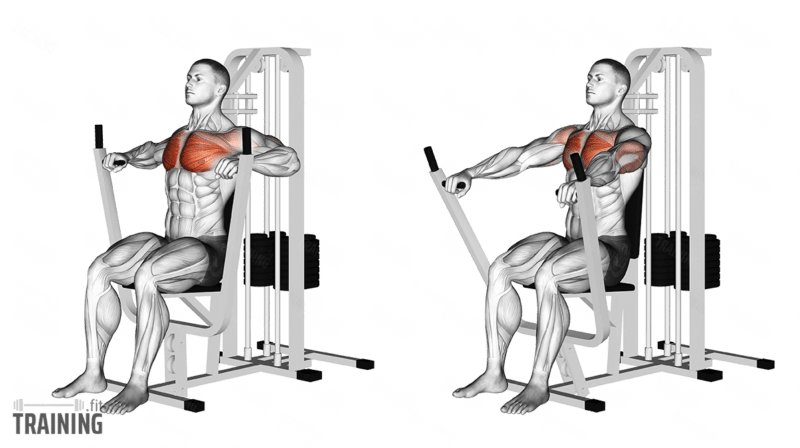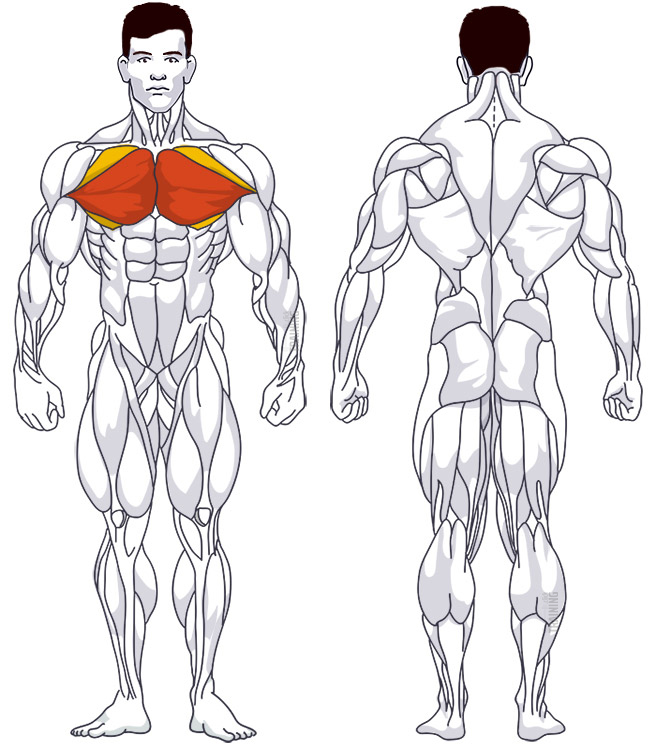Chest Press
Isolation exercise, MachineOverview

Main muscles
- Chest: Large pectoral muscle
(Musculus pectoralis major)
Chest Press: Basics and alternatives

Involved main muscle groups:
Chest Press
The chest press is a popular machine exercise you’ll often see at the gym. It imitates the bench press, with you pushing weight away from your chest while seated. This targets the large pectoral muscle in isolation.
Another great machine exercise to enhance your chest workout is the machine chest fly, where you squeeze weights with your extended arms, also isolating your chest.
Since you don’t need to stabilize the weight like you would with a flat bench press (using either dumbbells or a barbell), the triceps and front shoulder are less engaged.
Correct execution
The chest press is perfect for beginners and can be a useful way to finish a heavy chest training session. It’s great for beginners because the machine guides the movement and doesn’t require stabilization.
If you’re new to strength training, the chest press offers a simple and safe introduction to prepare for the bench press. Once you’ve mastered the movement and increased your training weight, you can confidently move on to the bench press.
Some chest press machines provide a second handle option. The hammer grip – with your palms facing parallel to each other – activates the lower chest a bit more. However, the chest press is usually performed with an overhand grip (palms down).
Video tutorial
Step-by-step instructions
Sit on the machine’s seat. Adjust the seat height so the handles are at chest level. Set the weight, starting a bit lower if it’s your first time using the machine.
On some chest press machines, you can also adjust the grip depth, changing the resting position of the handles. Ensure the handles aren’t too far back to avoid straining your shoulders. Some machines have a foot lever to help move the handles into position. In any case, make sure your hands aren’t behind your chest in the starting position.
Press your back into the back pad and keep your head upright.
Controlledly push the handles forward. Don’t fully extend your elbows at the end of the movement; keep them slightly bent to maintain muscle tension.
Consciously follow the machine’s movement. On some machines, you push the handles directly forward, while on others, the handles move up at a slight angle.
Lower the weight back down in a controlled manner, returning your hands to the starting position. The moved weight shouldn’t touch the stationary weight at the end or beginning of a repetition. Only put the weight down when you finish the set.
Common mistakes
Make sure to adjust the seat height so the handles are at chest level. This ensures maximum pectoral activation and reduces joint stress.
Also, don’t fully extend your arms at the end of the pressing motion; keep your elbows slightly bent and muscles tense. Fully extending your arms shifts pressure to your elbow joints, potentially causing long-term wear and tear.